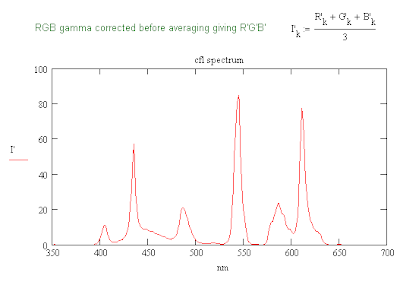 This plot suggests that the color temperature might be higher than data sheet indicated. It is similar to that of the "narrow band" illuminants F10-12 and seems to lie between F12 and F11. The bulb used was not exactly the same as those listed in the datasheet.
This plot suggests that the color temperature might be higher than data sheet indicated. It is similar to that of the "narrow band" illuminants F10-12 and seems to lie between F12 and F11. The bulb used was not exactly the same as those listed in the datasheet.Friday, August 13, 2010
Using Exposures Instead of RGB Values
The exposure of a pixel represents the quantity of light captured by it when a picture is taken and presumably this is gamma compressed to give the RGB values. So before adding these values together they would have to have the gamma corrections applied to them. This would include the values used for averaging over the a number of pixels to smooth the results. In Fink's Television Engineering Handbook (1957), Ch. 4, p. 9, which uses the CIE 1931 color system, it is stated that at each wavelength that a match is made the luminance of a spectral line is equal to the sum of luminances of the RGB components. The implication is that we just have to add the gamma corrected RGB values to get the total illumination. Division by three doesn't affect the relative illumination of a pixel. The result is then closer to the response that one would expect for the eye being greatest for the 546 nm spectral line of mercury (Hg).
 This plot suggests that the color temperature might be higher than data sheet indicated. It is similar to that of the "narrow band" illuminants F10-12 and seems to lie between F12 and F11. The bulb used was not exactly the same as those listed in the datasheet.
This plot suggests that the color temperature might be higher than data sheet indicated. It is similar to that of the "narrow band" illuminants F10-12 and seems to lie between F12 and F11. The bulb used was not exactly the same as those listed in the datasheet.
 This plot suggests that the color temperature might be higher than data sheet indicated. It is similar to that of the "narrow band" illuminants F10-12 and seems to lie between F12 and F11. The bulb used was not exactly the same as those listed in the datasheet.
This plot suggests that the color temperature might be higher than data sheet indicated. It is similar to that of the "narrow band" illuminants F10-12 and seems to lie between F12 and F11. The bulb used was not exactly the same as those listed in the datasheet.
Subscribe to:
Post Comments (Atom)
No comments:
Post a Comment